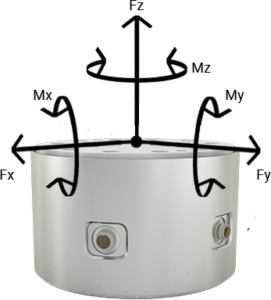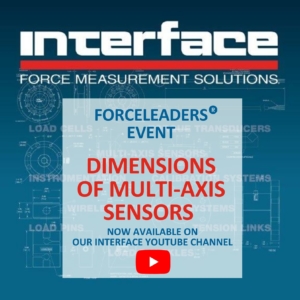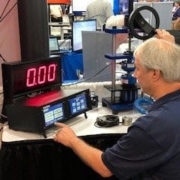Dimensions of Multi-Axis Sensors Virtual Event Recap
 The Interface ForceLeaders hosted forums are designed to answer frequently asked questions from testing engineers and product designers about new technologies and uses cases. In our recent virtual event, Dimensions of Multi-Axis Sensors, we discussed the considerations for these types of sensors, the test and measurement benefits, products Interface offers and various applications.
The Interface ForceLeaders hosted forums are designed to answer frequently asked questions from testing engineers and product designers about new technologies and uses cases. In our recent virtual event, Dimensions of Multi-Axis Sensors, we discussed the considerations for these types of sensors, the test and measurement benefits, products Interface offers and various applications.
Interface recognizes that there are growing demands for multi-axis sensors. In our hosted event, Interface’s Brian Peters kicked-off the conversation by highlighting benefits and reasoning for the use of these types of sensors, including answering some common questions. We’ve provided a recap of the event below or you can watch the event here https://youtu.be/zua1lvTh488.
What is Unique about Multi-Axis Sensors?
Multi-axis sensors have additional bridges to provide output signals for varying axes or types of mechanical loading. They are designed to measure a multitude of forces and moments simultaneously with a single load cell sensor. Fundamentally similar to other force and torque sensors with strain gage bridges bonded to machined “flexures,” each bridge typically defines a measurement axis.
 There are multiple configurations of 2, 3, or 6-axis options.
There are multiple configurations of 2, 3, or 6-axis options.
- Axial + Torque
- Axial + Shear
- Axial + Moment
- All 6 degrees of freedom
Should You Use Multi-Axis Sensors?
The largest factor to consider is the accuracy of your test model. In many test applications using standard load cells we often notice side or eccentric load, which can skew your data. While many Interface load cells, particularly mini load cells, have been designed to reject indirect loads, nothing can handle side and eccentric loads quite like a multi-axis sensor. Dedicated multi-axis designs are typically more balanced axis capacity limits with discrete signal outputs. Composite signal outputs are common in 6-axis models.
What are the Benefits of Multi-Axis Sensor Technology?
There are a number of benefits to using multi-axis sensors in addition to accounting for and accurately measuring or rejecting side and eccentric load. These benefits include:
- Consolidate measurement signals, conserve test space
- Measure unwanted system crosstalk
- Quantify reaction loads through test article on “non-measure” side
- More successful fatigue testing through setup and load verification
- More data, more understanding, more complete picture
What Considerations Should Engineer Make When Using Multi-Axis Sensors?
If you’ve made the decision to utilize a multi-axis sensor in your test model, please note the following considerations:
- System-level loads and geometry
- Maximum loading conditions
- Chosen capacity is adequate for measurement loads as well as potential peak or extraneous loads
- Choosing the right sensor based on primary axis measurements
Interface Multi-Axis Sensor Products
Ken Bishop details various types of multi-axis sensor technology from Interface during the highlighted ForceLeaders event you can watch here. Interface offers a wide range of multi-axis sensors, including 3-axis, 6-axis, axial torsion and 2-axis versions. The product options give you the ability to measure forces simultaneously in three mutually perpendicular axes, with the 6-axis load cells also measuring torque around those axes.
AXIAL TORSION LOAD CELLS
Interface’s axial torsion load cell is used for measuring both torque and force in a single sensor. Typical applications of its axial torsion transducer include bearing test and material test machines. The features of our axial torsion load cell include minimal cross talk, extraneous load resistance, and the load cell is fatigue rated. Customers can also add the following options: an integral cable, compression overload protection, and connector protectors.
2-AXIS LOAD CELLS
The Interface 2-Axis load cells can measure in two directions, X and Y simultaneously. It is commonly used in applications where dual-axis measurement is important in design and testing. They are effective for applications that measure lateral forces and the narrow design fits into compact areas.
2-Axis Interface Products:
- TXY 2-Axis Force Load Cell
- AT101 2-Axis Axial Torsion Load Cell
- AT102 2-Axis Axial Torsion Load Cell
- 2816 2-Axis Axial Torsion Load Cell
- 1216 2-Axis Axial Torsion Load Cell
- 1516 2-Axis Axial Torsion Load Cell
- 5600 2-Axis Axial Torsion Load Cell
- AT103 2-Axis Axial Torsion Load Cell
3-AXIS LOAD CELLS
Interface’s 3-axis load cell measures force simultaneously in three mutually perpendicular axes: X, Y, and Z – tension and compression. Each axis provides a unique mV/V output and requires no mathematical manipulation. The 3-axis load cell is built to minimize eccentric loading effects and crosstalk between axes. We offer five different models in its 3A Series 3-axis load cell designed for a wide variety of capacities. They are compact in size, provide 3 full bridge mV/V outputs with an IP68 option.
3-Axis Products:
6-AXIS LOAD CELLS
Interface’s 6-Axis Load Cell measures force simultaneously in three mutually perpendicular axes and three simultaneous torques about those same axes. Six full bridges provide mV/V output on six independent channels. A 36-term coefficient matrix is included for calculating the load and torque values in each axis. An 8-channel amplifier with a USB PC interface is also available which simplifies data analysis. The company offers five different models of 6-axis load cells for a wide variety of capacities. In the end, they provide more data, accuracy, are very stiff and cost-effective for a wide range of testing options.
6-Axis Products:
Keith Skidmore, an application expert at Interface, outlined a number of use cases spanning across multiple industries. They included testing programs using multi-axis sensors in automotive, medical, aerospace and defense, consumer packaging and more. Some of the application notes discussed during this recorded event include:
- Wind tunnel testing
- Aerospace structural and fatigue testing
- Computer model validation
- Friction testing
- Medical device: ball socket testing
- Prosthetics
- Robotic arm
- Hydrofoil
- Seat testing
- Center of gravity
Be sure to watch the YouTube video below to gain insight into some of the most frequently asked questions about multi-axis sensors.
We had a great time introducing our audience to the possibilities of Interface Multi-Axis Sensors. If you are interested in watching the video on demand of the webinar, you can click on the link below to watch the presentation in its entirety.









